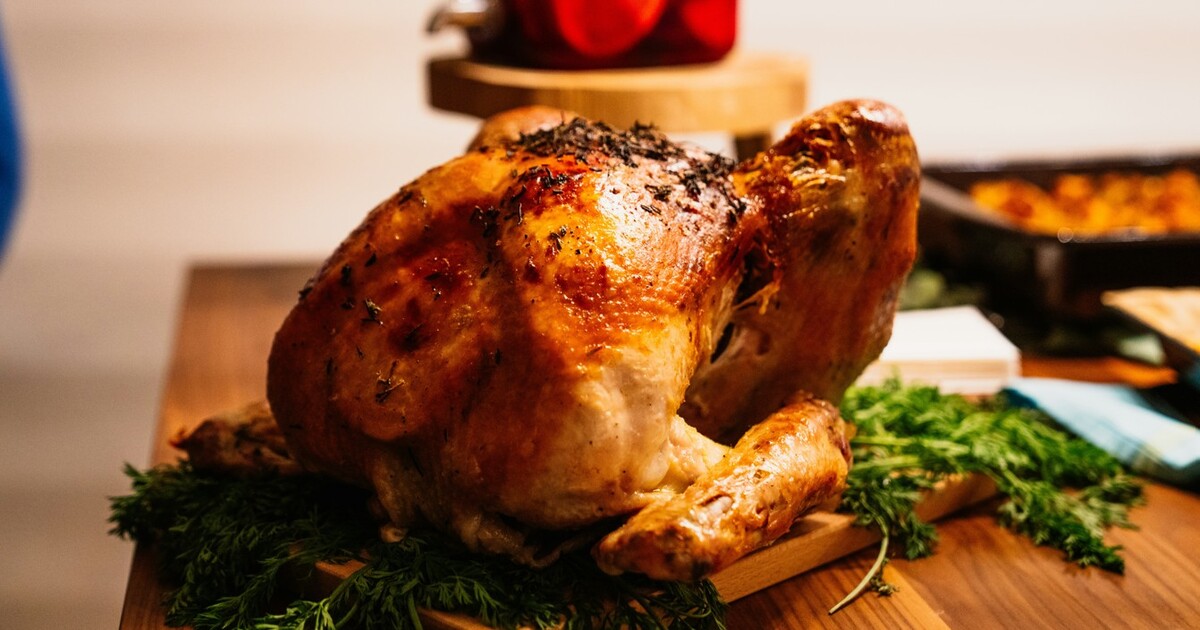Giving the Turkey the Bird?
A history of Thanksgiving and a recipe for chard gratin.
November 27, 2025

Thanksgiving is my favorite celebration of the year. Christmas is so much more stressful, fraught as it usually is with its imbalance of excess and fragility of temper.
Thanksgiving also comes with so much less family pressure and expectation. There are no presents to exchange and disappoint. Guests arrive and leave promptly, well inside twelve hours. There are no social obligations for the following day bar spending too much time and money at the mall, if that’s your thing.
How times have changed
While the first Thanksgiving with the English colonists and their Wampanoag hosts in the autumn of 1621 in Plymouth, Massachusetts, is said to have lasted three days, now the whole occasion is over and done with in one. What’s not to like?
Confession time: The turkey? Also pumpkin pie. The former is generally dry and causes cooks to come up with exotic preventative measures like deep frying it or stuffing it with other small birds. It hangs around for days being picked at standing at the open fridge (quite the most delicious way to enjoy it) until you finally arrive at the best part, its carcass, which makes a magnificent broth.
English goose fairs
We all love traditions. In England, thankfully goose — not turkey — at Christmas is one. Goose fairs, of which there are still four, have been around since 1284 when King Edward I granted Nottingham a royal charter for a fair.
It was named for the up-to-20,000 geese driven from the fens in the east of the country for selling at Nottingham’s market. To protect them on the 50 mile walk, the birds’ feet were coated with a mixture of tar and sand.
Goose fair day
“Goose Fair Day,” as Borough Records of 1541 refer to the event, was originally held for eight days, starting on September 21 to celebrate the feast of St. Michael and All Angels. Michaelmas marked with harvest celebrations the transition from summer into autumn. When the Gregorian calendar was adopted in Britain in 1752, the date was moved to early October.
Since the very first Nottingham Fair, it has only five times not taken place — once in 1646 after an outbreak of the bubonic plague, again during the First World War and the Second World War, then in 2020 with Covid.
In 2021, it was canceled when the organizers rejected plans to install perimeter fencing and an entrance fee. Gosh. The possibility of making money dismissed? Hurrah for them!
Back to turkeys
Back to that American bird, wild turkeys were originally domesticated by the indigenous people of Mexico and North America, around 2000 years ago. They first arrived in Spain in 1519, brought back from Mexico by Spanish explorers.
Soon after, they were introduced to Britain, affordable only by the wealthy. Henry VIII is said to have been the first king to eat it for Christmas. Then, 14 reigns later, Queen Victoria instituted it as the royal Christmas bird at a time when the development of the railway network lowered the cost of their transportation from distant farms to market.
But it wasn’t the prime national centerpiece of the feast until after the Second World War when turkey farming became widespread and the price of the bird, which feeds many more mouths than does a goose, much cheaper.
Origins of the name
Their name came from the fact that they reminded Europeans of the guinea fowl that had previously been introduced by traders of the Ottoman Empire, a region known as Turkey.
However, there isn’t any consensus. The French call the bird a “dinde” — “from India,” while the Greeks call it a “gallopoulo” — “from France.” The Turks call it a “hindi” — an Indian, and the Russians call it a “turtsiya” — a Turk. In Portugal, it’s a “peru.”
My favorite part of the Thanksgiving feast is what goes with the bird. A Washington D.C. friend makes the world’s best stuffing, with cornmeal and chilies and more, and is wise enough to bake it in a dish and not inside the bird, to provide a plentiful amount for greedy guests.
Another friend makes a spectacular corn “pudding,” the eating of which is like lying ill in bed and having one’s gently crooning mother spoon-feed comfort into the mouth.
A different Thanksgiving side dish
This dish is from Bruno’s Cookbook. All you need to do to make it vegetarian is leave out the ham in the crumb topping, as I had with one for them.
If you do not fancy it as a different Thanksgiving side dish, it is a useful one to have in the freezer as something to bung in the oven any time of year when you have guests and their tickle of hunger emerges, but you are too tired to move. Toss over it chunks of goats cheese or feta and you have a filling main course.
Ingredients
(Serves 4-6)
115g/4oz very thinly sliced Parma ham (optional)
50g/1¾oz coarse fresh breadcrumbs
2 tablespoons olive oil
1 tablespoon fresh thyme leaves
130g/4¼oz cheese – Cheddar or Parmesan, grated (but you can add much more if you wish)
500g/1lb bunch chard (Rainbow chard is prettiest), leaves pulled off, stalks sliced diagonally 2cms/1in wide
355ml/12fl oz milk
155ml/5fl oz single cream
100g/3½oz butter
65g/2¼oz flour
A light grating of nutmeg
Salt and white pepper to taste
Method
Preheat oven to 150C/300F. Place the ham on a parchment-lined baking sheet. Bake until crisp, 5-10 minutes. Cool then snap into pieces. Raise oven temperature to 200C/390F.
Combine breadcrumbs and 2 tablespoons of oil in a frying pan. Toss over medium heat, until golden brown and crisp. Off heat, add the thyme and 25g/¾oz cheese and season. Mix in the ham pieces if using and set aside.
Blanch the chard stalks in salted water for about 5 minutes then drain and add to a bowl of cold water. Add the leaves to the boiling water and drain as soon as they wilt then squeeze out as much liquid as possible. Drain the stalks from the cold water, mix with the leaves and set aside.
Heat the milk and cream to just sizzling. Melt 70g/2½oz butter in a heavy-bottomed pan, add the flour and stir till sandy and gold. Slowly pour in the hot liquid, stirring, till it begins to boil and form a medium-thick bechamel sauce. Beat in the remaining cheese and seasonings.
Butter a gratin dish with the remaining butter. Fold the chard into the sauce, pour into the dish and sprinkle the breadcrumbs over. Bake for 15-20 minutes till bubbling and gold.
Takeaways
The French call turkey a “dinde” — “from India,” while the Greeks call it a “gallopoulo” — “from France.” The Turks call it a “hindi” — an Indian, and the Russians call it a “turtsiya” — a Turk. In Portugal, it’s a “peru.”
Thanksgiving is my favorite celebration of the year. Christmas is so much more stressful, fraught as it usually is with its imbalance of excess and fragility of temper.
While the first Thanksgiving with the English colonists and their Wampanoag hosts in the autumn of 1621 in Plymouth, Massachusetts, is said to have lasted three days, now the whole occasion is over and done with in one. What’s not to like?
Since the very first Nottingham Fair, it has only five times not taken place — once in 1646 after an outbreak of the bubonic plague, again during the First World War and the Second World War, then in 2020 with Covid.
Wild turkeys were originally domesticated by the indigenous people of Mexico and North America, around 2000 years ago. They first arrived in Spain in 1519, brought back from Mexico by Spanish explorers.

